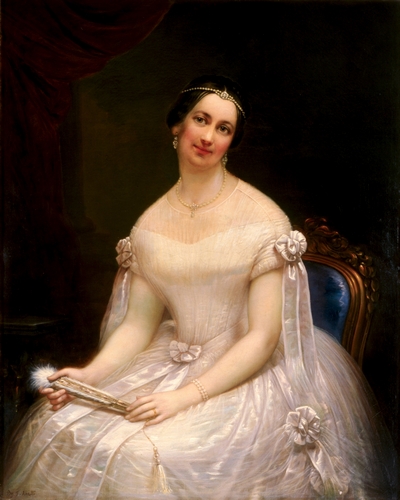Julia Gardiner Tyler (Julia Gardiner Tyler)

Julia Gardiner Tyler was born in 1820 on Gardiner’s Island off the eastern tip of Long Island, New York, one of the largest privately owned islands in the United States. She was the daughter of David Gardiner, a prominent landowner and New York State Senator from 1824 to 1828, and his wife Juliana née McLachlan. Julia was raised in the New York town of East Hampton as well as in the small hamlet of Bay Shore, Long Island; Bay Shore was called Penataquit until 1868, and even earlier, Awixa. At the age of 19, she shocked polite society by posing on the arm of a gentleman who was not her relative for a handbill advertising a middle-class department store that billed her as the “Rose of Long Island”. She was almost immediately sent to Europe in the hope of improving her social graces.
In early 1842, Julia was introduced to President John Tyler at a White House reception. Initially the high-spirited and independent-minded northern beauty felt little attraction to the grave, reserved Virginia gentleman, who was thirty years her senior. Julia enjoyed the President’s gallant and flattering public attentions but laughingly replied “no, no, no” to his first marriage proposal. But they began seeing each other in January 1843, only a few months after the death of First Lady Letitia Tyler.
Julia, her sister Margaret, and her father joined a presidential excursion on the new steam frigate Princeton. David Gardiner, along with a number of others, lost his life in the explosion of a huge naval gun. Julia was devastated by the death of her adored father. She spoke often in later years of how the President’s quiet strength sustained her during this difficult time. Tyler comforted Julia in her grief and won her consent to a secret engagement, proposing in 1843 at the George Washington Ball. Because of the circumstances surrounding her father’s death, the couple agreed to marry with a minimum of celebration. Thus on June 26, 1844, the president slipped into New York City, where the nuptials were performed by the Right Reverend Benjamin Treadwell Onderdonk, fourth bishop of the Episcopal Diocese of New York, at the Church of the Ascension, not too far from the Gardiner’s residence on LaGrange Terrace. President Tyler was 54 years old, but looked 10 years older, while Julia was just 24; Tyler’s oldest daughter, Mary, was 5 years older than her father’s new wife.
The bride’s sister Margaret and brother Alexander were bridesmaid and best man. Only the president’s son, John Tyler III, represented the groom’s family. Tyler was so concerned about maintaining secrecy that he did not confide his plans to the rest of his children. Although his sons readily accepted the sudden union, the Tyler daughters were shocked and hurt. The news was then broken to the American people, who greeted it with keen interest, much publicity, and some criticism about the couple’s difference in age of 30 years. It was awkward for the eldest Tyler daughter, Mary, to adjust to a new stepmother five years younger than herself. One daughter, Letitia, never made peace with her stepmother.
After a wedding trip to Philadelphia, a White House reception, and a stay at Sherwood Forest, the estate the president had recently acquired for his retirement, the newlyweds returned to Washington. Although her husband was often visibly fatigued by the exertions of marital life, the fresh and youthful Mrs. Tyler thoroughly enjoyed the duties of First Lady. In the last month of the Tyler administration, she hosted a grand White House ball that drew 3,000 guests.
The Tylers retired to Sherwood Forest, where they lived tranquilly until the Civil War. Although a northerner by birth, Mrs. Tyler soon grew accustomed to owning slaves and enjoying the leisurely routines of daily life as the wife of a wealthy plantation owner. Defending slavery as a humane and even enlightened institution, she soon became an ardent supporter of the principles of the South.
After her husband’s death in 1862, Julia moved north to Staten Island, where her sympathy for the Confederates strained relations with her family (her home there was almost burned down by enraged Union veterans when it was discovered that she was flying a Confederate flag on the property). She resided at the Gardiner-Tyler House from 1868 to 1874. It was added to the National Register of Historic Places in 1984. The depression that followed the Panic of 1873 depleted her fortunes. She sought solace in Roman Catholicism, to which she had converted in 1872. She returned to Virginia to live with the aid of her grown children and, in her last years, a federal pension provided to all presidential widows. She suffered a stroke while in Richmond and, on July 10, 1889, died there, aged 69. She was buried next to the president at Hollywood Cemetery in Richmond.
Born
- May, 17, 1820
- USA
- Gardiners Island, New York
Died
- July, 10, 1889
- USA
- Richmond, Virginia
Cemetery
- Hollywood Cemetery
- Richmond, Virginia
- USA

